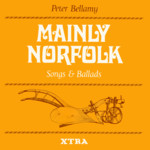> The Watersons > Records > Frost and Fire
The Watersons: Frost and Fire
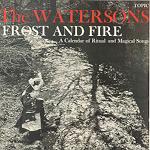 |
Frost and Fire Topic Records 12T136 (mono LP, UK, 1965) |
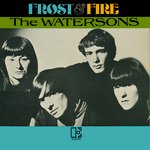 |
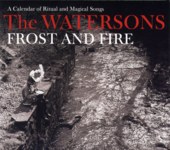 |
Topic Records TSCD563 (CD, UK, 7 May 2007) |
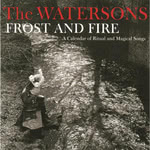 |
Recorded by Bill Leader in the back room of his Camden Town flat in 1965.
Produced by Tony Engle.
1965 photograph on both LP and CD by Sally Shuel.
Every Good Friday the Midgley Pace Egg is performed by boys at several places in the Calder Valley, Yorkshire. There are nine players and the photograph on the sleeve shows one of them, the Bugler.
The LP was re-released on CD in 1990 with the addition of half the tracks from the LP Sound, Sound Your Instruments of Joy. Both LPs were finally released on CD in their original form in 2007. Also, nine of the Frost and Fire tracks and two from Sound, Sound Your Instruments of Joy were included on the 1996 Topic sampler The Season Round.
Musicians
Mike Waterson, Norma Waterson, Lal (Elaine) Waterson, and their second cousin John Harrison: vocals
with
Bill Leader: drum [7];
Gabriel’s Horns (Steve Heap: cornet; John Adams: trombone;
Tony Engle: C melody saxophone; Alex West: tuba) [17]
Tracks
LP Side 1
- Here We Come A-Wassailing (Roud 209; TYG 22) (1.22)
- The Derby Ram (Roud 126; G/D 3:645; TYG 59) - Mike (2.31)
- Jolly Old Hawk (Roud 1048) (1.05)
- Pace-Egging Song (Roud 614; TYG 53) (3.09)
- Seven Virgins (The Leaves of Life) (Roud 127) - Norma (2.06)
- The Holly Bears a Berry (The Sans Day Carol) (Roud 514) (2.27)
- Hal-an-Tow (Roud 1520) (2.00)
LP Side 2
- Earsdon Sword Dance Song (Roud 610) (2.57)
- John Barleycorn (Roud 164; G/D 3:559) (3.16)
- Harvest Song: We Gets Up in the Morn (Roud 2471) (1.15)
- Souling Song (Roud 304) (1.26)
- Christmas Is Now Drawing Near At Hand (Roud 808) - Lal (1.47)
- Herod and the Cock (Roud 306; Child 55) (0.59)
- Wassail Song (Roud 209) (3.02)
1990 CD Bonus Tracks
The 1990 CD reissue has seven additional tracks taken from the LP Sound, Sound Your Instruments of Joy:
- God Bless the Master (Roud 1066) (3.05)
- The Bitter Withy (Roud 452) - Mike (2.34)
- Emmanuel (Roud 26895) -Lal and Norma Waterson with chorus accompanied by Gabriel’s Horns (2.48)
- Idumea (Roud 6678) (1.48)
- Sound, Sound Your Instruments of Joy (Roud 8366) (4.28)
- Come All Ye Faithful Christians (Roud 815) - Norma (2.28)
- Green Fields (Roud 3385) (2.41)
Sleeve Notes by A. L. Lloyd
Seasons of anxiety, seasons of joy. The common people had their rites of propitiation and triumph, older than the rituals of the Church and closer bound to their daily lives. This record takes us through a year’s calendar, displaying songs that accompanied these ceremonies, season by season.
What are the songs really about? Let’s begin with Adam and Eve. The first men plucked their food from bushes and trees, and in open country they become hunters. They learned to tame animals, to grow food plants, and turned herdsmen and agriculturists. When plants and beasts abounded, life was good. If they withdrew, people starved. Fertility was vital. Its stream dwindled in winter, ran again in spring time. Gradually people got the idea of trying to stimulate that fertility by performing stamping dances to waken the earth, leaping dances to provoke crops to grow high and bulls to breed. They tried to bind the potency of nature to themselves, dressing in green leaves or animal skins to perform their magic ceremonies, ritually eating and drinking enormously at certain seasons to take into themselves extra portions of the vital spirit dwelling in sacred animals and plants. Man was on the point of inventing the gods.
The most gifted man in the community took the lead. He was the medicine man, the priest, the king, the representative of divine power. He was the one who dressed in skins or leaves, who killed the sacred animal, cut the sacred tree, led the earth-shaking dances of springtime, lit the reassuring bonfire of midwinter, headed the bands of heroes who marched through the village at critical seasons, singing and dancing for good luck and fine crops, and extracting their rewards for driving off the demons of sterility and want. And because the medicine man was the representative of all that’s fecund, in early times he was killed even before his potency faded so that another vigorous representative could take his place and the continuance of fertility assured. Eventually, as manners softened, the ceremony involving this ritual slaughter, a rite compounded of anxiety, hope and remorse, changed its character. Instead of the king, a slave, a prisoner of war, an animal even was sacrificed, and finally the ceremony became a symbolic spectacle, a pantomime dance of death and resurrection that comprised the first folk play and thus the beginning of all theatre.
When the Christian church arose, it ranged itself against the beliefs and customs of the old nature worship, and prudently annexed many of the seasonal ceremonies. Thus the critical time of the winter solstice, a rich period for pagan ritual, became the season of the Nativity of the new god. The season of the great spring ceremonies became the time of his slaughter and resurrection. So it happens that in many songs on this record pagan and Christian elements are inextricably tangled. So much is talked of myth and sun worship and such, that it’s necessary to recall that behind most of these calendar customs and the songs attached to them lies nothing more mysterious, nothing less realistic, than the yearly round of work carried out in the fields. We’ve divided our cycle of customs according to the calendar seasons--winter, spring, summer, autumn and winter again. Less formally, we might better have divided them according to the economic seasons--the ploughing, sowing, augmentation and harvesting of crops. For it’s due to their relation with economic life, not to any mystical connection, that the song-customs have persisted right up to our own time. Just as one doesn’t need to be an ancient Greek to be moved by the plays of Aeschylus, so it’s not necessary to be anything other than an ordinary freethinking twentieth century urban western man with a proper regard for humankind, to appreciate the spirit and power of these songs. To our toiling ancestors they meant everything, and in a queer irrational way they can still mean much to us.

